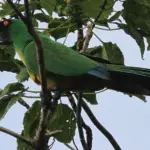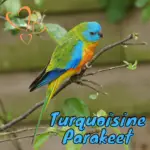
Swift Parrot 25 cm; 50–74 g. Green, with forehead and front of the face, chin, and throat red outlined with yellow except for a deep blue patch on mid-crown; underwing-coverts, under tail-coverts, shoulder and lesser wing-coverts red, outer secondary coverts tinged blue, primary coverts and primaries dark bluish;
some red feathers on flanks, but individually variable; tail dark reddish above, dull grey below. Swift Parrot Female similar. Immature duller, with less red.
Describer is previously given as J. White. Monotypic.
Subspecies
Monotypic.
Distribution
Tasmania, Swift Parrot breeding mostly along the SE coast. Winters in SE & E Australian mainland from SE South Australia to SE Queensland, especially in C Victoria.
Swift Parrot Habitat
Inbreeding season eucalypt forests, especially those with blue gum (Eucalyptus globulus), but also gardens and parks. In winter remnant open forest areas within agricultural land, parklands, and suburbs.
Swift Parrot Population
SOURCE: Plumes of Oz
Movement
Austral migrant, moving to Australian mainland Jan–May, a few birds remaining in Tasmania year-round; on wintering grounds irregularly dispersive and nomadic,
following eucalypt flowering and psyllid lerp infestations, except at the center of distribution in S & C Victoria, unless occasional widespread flowering allows large-scale movements throughout the winter range.
Swift Parrot Diet
Pollen and nectar, especially from Eucalyptus blossoms, in particular blue gum, but also Banksia and Xanthorrhoea flowers, supplemented by insects and their larvae, notably psyllid lerps, fruit, berries, and seeds.
On the mainland dependent on winter-flowering eucalypts, notably E. sideroxylon, E. leucoxylon, E. albens and E. ovata, and on E. viminalis in autumn.
Sounds and Vocal Behavior
The commonest vocalization of Swift Parrot is a distinctive double note “chit-chit” and longer twittering series of the same note. When feeding, also musical warbling notes. An alarm calls a series of sharp notes “Kik”.
Breeding
Oct–Jan. Swift Parrot Nest in a hole 7–20 m up in a tree, usually a mature or senescent blue gum, often semi-colonially, sometimes with Neophema Chrysostom; once in a crevice in the wall. Swift Parrot Eggs 3–5; in captivity, incubation lasting c. 20 days, and nestling period c. 10 weeks.
Swift Parrot Endangered
CRITICALLY ENDANGERED. CITES II. Restricted-range species: present in Tasmania EBA.
Breeding and wintering distributions vary considerably from year to year in response to rainfall, which affects the availability of food.
The range appears to have contracted, with only irregular recent records of small flocks or individual birds from the southeast of the state. Population estimate of c. 2000 mature individuals, declining.
The abundance of E. globulus is greatly reduced in Tasmania: some 56% of the original grassy E. globulus forest in Tasmania has been cleared; the remaining 8000 ha is found on private land, only 1500 ha is protected.
Forest clearance within the Tasmanian breeding range continues to be the main threat, with a similar loss of mature, productive winter food trees; some illegal trapping has also occurred.
Sand some birds are still trapped illegally for trade, though the species does poorly in captivity. Competition for nest sites with Common Starlings Sturnus vulgaris and for food with the introduced bumblebee Bombus Terrestris is undocumented potential problems.
The sugar glider (Petaurus breviceps), an introduced marsupial, has been found to be a serious nest predator eating over 50% of nesting females; a recent population viability analysis projected a mean 86·9% decline over three generations (16 years) and therefore suggested listing the species as Critically Endangered, a move which was ratified in 2015.
Currently considered Endangered at the national level in Australia, although a proposal for uplisting to Critically Endangered was submitted in 2015.
Continued planting of blue gum as shelterbelts and ornamentals is important for the survival of this species. Public lands harboring the species should be managed in their favor and management agreements should be sought for private properties.
Climate change may pose another threat to the Swift Parrot, since almost a quarter of nesting habitat, predominantly in NE Tasmania, is projected to become climatically unsuitable by the end of the 21st century.
SOURCE: ABC Science




















